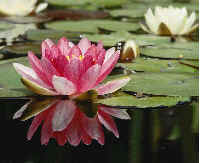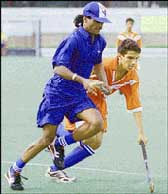|
|
|
Home*
Biography*
Social*
HAM Radio*
Genealogy*
Islam*
India*
Photo Gallery* Tamil* Favorites* Links* Contest* Awards* Converters* Visitors* Site Map* Guest Book* EMail |

|
|
|

Quotations by M.K.Gandhiji |
This page contains brief history about my country. I love my country very much. It represents my feelings for my great country and for my responsibilities to this world that Almighty has created. I pray for world peace.
India can legitimately claim to be a grand old civilisation in terms of its philosophy, tradition and culture of peaceful co-existence and unity in extreme heterogeneity. It has given a cultural mosaic, where all segments have contributed to the growth of fused and balanced ways of expression and behaviour. It has also made a mark as a nation in adopting a liberal democratic and secular Constitution. Indian Constitution for the first time in history of India addresses Indian citizens in the name of "We, the people of India". The political system commits to ensure equality, liberty, fraternity and justice to all. Thus, India as a civilisation and nation manifests a high quality commitment to equality, tolerance, rule of law and secularism. |
 |
|
| Continent | Asia |
| Population | Above One Billion (More than 100 Crores) |
| Area Total | 32,87,590 km2 |
| Area of Land | 29,73,190 km2 |
| Coast Line | 7,000 km |
| Capital | New Delhi |
| Climate | Varies from tropical monsoon in south to temperate in north. |
| Languages | Hindi, Tamil, Urdu, Bengali, Telugu, Marathi, Gujarati, Malayalam, Kannada, Oriya, Punjabi, Assamese, Kashmiri, Sindhi, Sanskrit, English |
| Currency | 1 Indian rupee (Rs) = 100 paise |
| People | Although India occupies only 2.4 percent of the world's land area, it supports over fifteen percent of the world's population. Only China has a larger population. Forty percent of Indians are younger than fifteen years old. About 70 percent of the people live in more than 550,000 villages, and the remainder in more than 200 towns and cities. Religion, caste, and language are major determinants of social and political organization in India today. The government has recognized sixteen languages as official; Hindi is the most widely spoken. Although 83 percent of the people are Hindu, India also is the home of more than 120 million Muslims, one of the world's largest Muslim populations. The population also includes Christians, Sikhs, Jains, Buddhists, and Parsis. Indeed, one of India's great legacies is the fact that it is the birthplace of both Hinduism and Buddhism. The population of India has a life expectancy at birth of 63.4 years (62.54 for males, and 64.29 for females) and an infant mortality rate of 60.81 deaths/1,000 live births. In terms of literacy, 37.7 pecent of the female population and 65.5 percent of the male population, age 15 and over, can read and write. |
| History | The people of India have had a continuous civilization since 2500 B.C., when the inhabitants of the Indus River Valley developed an urban culture based on commerce and sustained by agricultural trade. This civilization declined around 1500 B.C., probably due to ecological changes. During the second millennium B.C., pastoral, Aryan-speaking tribes migrated from the northwest into the subcontinent. As they settled in the middle Ganges River Valley, they adapted to antecedent cultures. The political map of ancient and medieval India was made up of myriad kingdoms with fluctuating boundaries. In the fourth and fifth centuries A.D., northern India was unified under the Gupta Dynasty. During this period, known as India's Golden Age, Hindu culture and political administration reached new heights. Islam spread across the subcontinent over a period of 500 years. In the 10th and 11th centuries, In the early 16th century, descendants of Genghis Khan swept across the Khyber Pass and established the Mughal (Mogul) Dynasty, which lasted for 200 years. From the 11th to the 15th centuries, the Hindu Chola and Vijayanagar Dynasties dominated southern India. During this time, the two systems, the prevailing Hindu and Muslim religions, mingled, leaving lasting cultural influences on each other. The first British outpost in South Asia was established in 1619, at Surat on the northwestern coast. Later in the century, the East India Company opened permanent trading stations at Madras, Bombay, and Calcutta, each under the protection of native rulers. The British expanded their influence from these footholds until, by the 1850s, they controlled most of present-day India, Pakistan, and Bangladesh. In 1857, a rebellion in north India led by mutinous Indian soldiers caused the British parliament to transfer all political power from the East India Company to the British Crown. Great Britain began administering most of India directly while controlling the rest through treaties with local rulers. In the late 1800s, the first steps were taken toward self-government in British India with the appointment of Indian councilors to advise the British viceroy and the establishment of provincial councils with Indian members; the British subsequently widened participation in legislative councils. Beginning in 1920, Father of Nation, Mahatma Gandhi, transformed the Indian National Congress political party into a mass movement to campaign against British colonial rule. The party used both parliamentary and non-violent resistance and non-cooperation to achieve independence. On 15 August 1947, India became a dominion within the Commonwealth, under Prime Minister Jawaharlal Nehru. India became a republic within the Commonwealth after promulgating its constitution on 26 January 1950. After independence, the Congress Party, the party of Mahatma Gandhi and Jawaharlal Nehru, ruled India under the influence first of Nehru, and then his daughter and grandson, with the exception of two brief periods in the 1970s and 1980s. Prime Minister Nehru governed the nation until his death in 1964. |
|
The Constituent Assembly
adopted the Indian national anthem from a song written
|
On the afternoon of August 15, 1947, during the first public flag salutation ceremony; as Tiranga was unfurled against a clear warm sky, a rainbow appeared on the horizon as though to bless Trianga. The design of the flag was adopted by the Constituent Assembly of India on July22, 1947. The ratio of width to length is 2 to 3. The use and display of the flag are regulated by the Indian Flag Code.
NATIONAL EMBLEM
Government of India Adopted this emblem, from the Sarnath Lion Capital of Asoka, on 26th of January 1950 as the national emblem. The National Emblem of India is a replica of the Lion of Sarnath, near Varanasi in Uttar Pradesh. The Lion Capital was erected in the third century BC by Emperor Ashoka to mark the spot where Buddha first proclaimed his gospel of peace and emancipation to the four quarters of the universe.The National emblem is thus symbolic of contemporary India's reaffirmation of its ancient commitment to world peace and goodwill.
The four lions (one hidden from view) - symbolising power, courage and confidence - rest on a circular abacus. The abacus is girded by four smaller animals - guardians of the four directions: the lion of the north, the elephant of the east, the horse of the south and the bull of the west.The abacus rests on a lotus in full bloom, exemplifying the fountainhead of life and creative inspiration. The motto 'Satyameva Jayate' inscribed below the emblem in Devanagari script means 'truth alone triumphs'.

The Tiger(Panthera tigris) is a symbol of grace, strength, agility and enormous power. The species found in India, known as the Royal Bengal Tiger, has a bright reddish tan, beautifully marked with dark, almost black, transverse stripes. The Royal Bengal Tiger is found throughout India.
NATIONAL BIRD
The Peacock, is strictly the male of Peafowl (Pava Cristatus) species of birds. It is fully protected under the Indian Wildlife Protection Act, 1972 (Peahen, the famale of the species is also protected), however, Peacocks have always been repected by the people on religious and sentimental grounds. Peacocks are found accross the Indian sub-continent.
NATIONAL FLOWER
The Lotus or waterlily is an aquatic plant with broad leaves and bright fragrant flowers that grow only in shallow waters. The leaves and flowers float. The big attractive flowers have many petals overlapping in a symmetrical pattern. The sacred Lotus is legendary and much folklore and religious mythology is woven around it.
NATIONAL FRUIT
Mango (species Mangifera indica) is a fleshy fruit that is rich in vitamins A, C and D. It is cultivated throughout India. Mangoes are vividly coloured with shades of red, yellow and green. The mango is inextricably connected with the folklore and religious ceremonies India. There are over 100 varieties of Mangoes, each variety having a distinct size, shape and colour.
NATIONAL TREE
Banyan, whose branches root themselves like new trees over a large area. The roots then give rise to more trunks and branches. Because of this characteristic and its longevity, this tree is considered immortal and is an integral part of the myths and legends of India. Even today, the banyan tree is the focal point village life and the village council meets under the shade of this tree.
NATIONAL GAME
Hockey is the National Game of India. Unmatched excellence and incomparable virtuosity brought India a string of Olympic gold medals. The Golden Era of hockey in India was the period from 1928 - 1956 when India won 6 consecutive gold medals in the Olympics. During the Golden Era, India played 24 Olympic matches, won all 24, scored 178 goals (at an average of 7.43 goals per match) and conceded only 7 goals. The two other gold medals for India came in the 1964 Tokyo Olympics and the 1980 Moscow Olympics.


|
India is my country, all Indians are my brothers and sisters. I love my country and I am proud of it's rich and varied heritage. I shall always strive to be worthy of it. I shall give my parents, teachers and all elders respect and treat everyone with courtesy. To my country and my people, I pledge my devotion. In their well-being and prosperity alone lies my happiness. |
|
There is no Law higher than Truth. Nation is Bigger than the Individual. Never go against the Law of the Land. Respect the Freedom of others and Love all. Have and cultivate Love for God and Fear of Sin. Abhor Sin. Ask not what your Country can do for you, Ask what you can do for your Country. Keep your house and surroundings clean for this will promote hygiene and health and help you. Curb envy and jealousy expand your vision and outlook; treat all equally regardless of caste, creed and religion. Practice charity, but do not encourage beggars by giving money. Provide them with food, clothing and shelter. Help them in other ways but do not encourage laziness. Have patriotism to your Nation - but do not criticise other Nations or put others down. Not even in your thoughts or dreams should you think of bringing grief to your country. |
"India is to me the dearest country in the world, not because it is my country but because I have discovered the greatest goodness in it." -Father of Nation
"India is marching towards a bright future. We have our share of problems. But these cannot hide the brightness on the horizon. It will be a future free of poverty and all other vestiges of underdevelopment. The day is not far when every region, every community and every citizen in our country shall enjoy the fruits of India's prosperity and progress. If we want, and if we act unitedly to get what we want, then this energizing goal can be achieved within the span of a generation... Is this a dream? Yes. Is it an impossible dream? No, it is not." -Prime Minister of India

I appeals to all my fellow citizens to Safeguard Peace, Harmony, Tolerance and Secularism to defend Democratic Values, The Constitution and the Rule of Law.
I let it be affirmed here once again: India is going to be the new power in the world, whether any nation likes it or not. And slowly but surely, this is coming to be acknowledged quite rightly.
I can proudly say: "SARE JAHANSE ACHCHA HINDUSTAN HAMARA" It would be the truth and not just a boast. I pray Almighty that it also joins the list of developed nations very soon.
JAI HIND!
| Go Back | Go Top | Go Next |